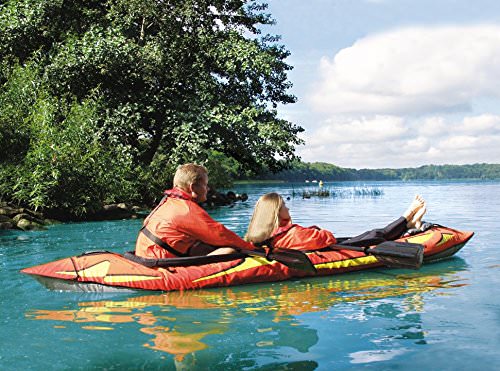Last Updated on January 8, 2023 by Afsar
The first time you see an inflatable kayak, you might think it’s not safe at all. How can something that looks like a blow-up pool be safe for open water? Well, as with anything related to boating, there are risks involved with an inflatable kayak. However, the risks are no different from any other type of boat. When deciding if an inflatable kayak is right for you and your skill set, there are many things to consider. There are many dangers linked to using small vessels in general; lakes and rivers can be unpredictable, and large bodies of water can be home to some treacherous creatures. But these factors apply whether you’re in a small fiberglass vessel or an inflatable one.
What are inflatable kayaks?
Inflatable kayaks are lightweight, portable boats designed for calm water such as rivers, lakes, and bays. They are made of a durable fabric material that is coated with a layer of rubber or plastic, and they have inflatable chambers that can be filled with air using a manual or electric pump. Inflatable kayaks are convenient to transport and store because they can be deflated and packed into a compact carrying bag when not in use. They are also easy to set up and take down, making them popular for recreational paddlers and travelers.
What are the materials used to make inflatable kayaks?
Inflatable kayaks are typically made of a durable fabric material that is coated with a layer of rubber or plastic. The most common materials used to construct inflatable kayaks are PVC (polyvinyl chloride) and hypalon. PVC is a synthetic plastic polymer that is known for its strength, durability, and affordability. It is commonly used in the construction of budget-friendly inflatable kayaks. Hypalon is a synthetic rubber material that is known for its superior durability and resistance to abrasions, UV rays, and extreme temperatures. It is used to construct high-end inflatable kayaks designed for use in rugged and demanding environments.
- PVC (polyvinyl chloride) is a synthetic plastic polymer commonly used to construct budget-friendly inflatable kayaks. It is known for its strength, durability, and affordability. PVC is resistant to punctures and abrasions and can withstand UV rays and extreme temperatures. However, it is not as durable as Hypalon and may not hold up as well in rugged or demanding environments.
- Hypalon is a synthetic rubber material that is known for its superior durability and resistance to abrasions, UV rays, and extreme temperatures. It is often used to construct high-end inflatable kayaks designed for use in rugged or demanding environments. Hypalon is more expensive than PVC, but it is more durable and resistant to wear and tear. It is also resistant to chemical exposure and less prone to cracking or fading.
How durable are inflatable kayaks?
Inflatable kayaks are generally quite durable and can last for many years with proper care and maintenance. However, they can be prone to punctures and leaks if they are used on rough terrain or handled roughly. To ensure the longevity of your inflatable kayak, it is important to follow the manufacturer’s instructions for care and use and to inspect the kayak for any damage or wear regularly. Additionally, it would help if you were careful not to drag the kayak over sharp objects or to expose it to extreme heat or cold, as this can weaken the material and increase the risk of punctures or leaks.
How Safe Are Inflatable Kayaks?
Inflatable kayaks are just as safe as any other type of boat. The primary difference between an inflatable and conventional kayak is the construction. Inflatable kayaks can make better in certain circumstances, but they are not necessarily safer in all cases. Hardshell kayaks usually have more durability than inflatable kayaks.
Inflated Kayak Safety Tips
Test the Inflatable Kayak First
Before taking an inflatable kayak out on the water, ensure it has no holes or other defects. Test it out in a pool or on a lake to ensure that it’s not leaking and that the seams are strong enough to withstand the water pressure. If you spot any issues, take it to a repair shop before taking it out on a real body of water.
- Inspect the kayak for any visible damage or wear before using it. Look for punctures, leaks, or frayed material. If you find any damage, repair it before using the kayak.
- Inflate the kayak to the recommended pressure according to the manufacturer’s instructions. It is important to use a high-quality air pump and to stop inflating once the kayak has reached the recommended pressure. Overinflating the kayak can cause damage.
- Sit in the kayak and make sure that it feels stable and comfortable. The kayak should sit evenly in the water and not rock or tip from side to side.
- Test the stability of the kayak by shifting your weight around. Lean from side to side and front to back to see how the kayak responds. It should remain stable and not tip over.
- Check all of the fittings and attachments, such as the seat, foot pedals, and any other accessories that came with the kayak. Make sure that they are securely attached and functioning properly.
- Take the kayak for a short test paddle in calm water to make sure that it performs as expected. Pay attention to how it handles, how it tracks through the water, and how comfortable it is to paddle.
Know Your Limits
Boaters of all kinds need to know their skill level and stay within their limits. The same goes for inflatable kayakers. Stay on a smaller lake or river if you don’t know how to handle an inflatable. You can always expand your skills and go out on the open ocean once you feel more confident in handling an inflatable.
Watch the Weather
No matter what kind of boat you’re using, you should always pay attention to the weather. If rain is in the forecast, put off your paddling plans for another day. If a storm is coming, find a safe harbor and wait out the weather.
Wear a Life Jacket
Even if you know how to kayak and have the steadiest hands, unexpected hazards can arise on the water. Wearing a life jacket always while you’re in the kayak is a good safety precaution.
Avoid Strong Currents
If you’re touring on a river, avoid going against the current. This will help you avoid unnecessary strain on your muscles and equipment. If you’re planning to go with the current, keep an eye out for strong eddies and currents in which you might get caught.
Be Cautious Around Wildlife
You’re still in the wild even if you’re paddling on a lake or a slow-moving river. Be cautious around wildlife that may be in or near the water.
Avoid Canal Paddling
Most canals are too narrow to fit an inflatable kayak. Even if you could squeeze the kayak into the canal, you probably wouldn’t get it out. Stay away from canals unless you’re in a fiberglass boat.
Stay Clear of Navigation Areas
While you’re on the water, make sure to stay clear of areas with heavy boat traffic. Avoid going near large vessels, and keep a respectful distance from ferries and other large craft.
Final Words: Is An Inflatable Kayak Right for You?
Inflatable kayaks are a fantastic option for people who want to kayak but don’t have the funds or space to store a regular kayak. They’re also great for people who want to paddle in a variety of bodies of water. You can take them out on lakes, rivers, and even oceans! Before buying an inflatable kayak, make sure you understand the risks associated with them and that you have the proper gear to stay safe.

Afsar is an avid kayak blogger born near the coast. He has a passion for kayaking and started as a child. He has paddled in various conditions and locations and promotes responsible kayaking. Afsar’s blog is widely read, and they are a respected voice in the kayaking community, offering valuable content on kayaking trips, gear, tips, and tricks. Afsar collaborates with other bloggers and brands and continues to inspire others through their writing and social media.

